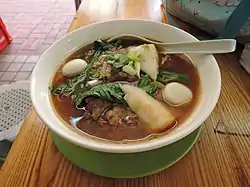 Cart noodles with beef soup | |
| Type | Noodles |
|---|---|
| Course | Main course |
| Place of origin | Hong Kong and Macau |
| Serving temperature | Hot |
| Main ingredients | Flour, egg and depend on toppings |
| Cart noodle | |||||||||||||||
|---|---|---|---|---|---|---|---|---|---|---|---|---|---|---|---|
| Traditional Chinese | 車仔麵 | ||||||||||||||
| Simplified Chinese | 车仔面 | ||||||||||||||
| Cantonese Yale | Chējái mihn | ||||||||||||||
| |||||||||||||||
| Alternative Chinese name | |||||||||||||||
| Traditional Chinese | 嗱喳麵 | ||||||||||||||
| Simplified Chinese | 嗱喳面 | ||||||||||||||
| Cantonese Yale | Láhjá mihn | ||||||||||||||
| |||||||||||||||


Cart noodle (traditional Chinese: 車仔麵; simplified Chinese: 车仔面) is a noodle dish which became popular in Hong Kong and Macau in the 1950s through independent street vendors operating on roadsides and in public housing estates in low-income districts, using carts.[1][2] Many street vendors have vanished but the name and style of noodle endures as a cultural icon.[3]
History
With many immigrants arriving from mainland China during the 1950s, hawkers would sell food out of a cart roaming the streets.[1] Some vendors specialising in cooked noodles would sell them with an assortment of toppings and styles.[4]
Historically, the cart frames were assembled out of wood with metallic basin, allowing the heat inside to cook the ingredients. In the past , it was possible to receive large quantities for a cheap price. The noodles were considered "cheap and nasty", with the cost kept low to appeal to the average citizen. Given this, the dish was also commonly referred as "filthy noodles" (嗱喳麵). Since hygiene standards rose, many street vendors, licensed or otherwise, have vanished.
Legacy
The name and style of the noodle endures, and remain widely available in low- to mid-end eateries. The price may vary depending on the combination of ingredients, or type of establishments. On the contrary, because the noodle is now defined by its retro style, it can sometimes be found in higher-end establishments. It may offer costlier types of ingredients at a higher price.
Typical combinations
Cart noodles is typically based upon the diner choosing various ingredients they would like, including the type of noodles, various soup broths, and toppings.[2] Examples of types of noodles and toppings, which may vary considerably from stall to stall:
Toppings
- Pig skin (豬皮)[5]
- Curdled pig's blood (豬紅)
- Pig intestine (豬大腸)[5]
- Pig oviduct (生腸)
- Red Chinese sausage (紅腸)
- Pork sausage[5]
- Chicken wing (雞翼)
- Spam (餐肉)
- Omasum (牛百葉)
- Beef ball (牛丸)
- Beef offal[5]
- Pork ball (豬肉丸)[5]
- Fried fishball (炸魚蛋)[5]
- Cuttlefish ball (墨魚丸)[5]
- Fishcake
- Crab stick (蟹柳)
- Octopus[5]
- Fried tofu[5]
- Wonton (雲吞)[5]
- Siu mai (燒賣)
- Green vegetables (蔬菜)[5]
- Chinese radish (蘿蔔)
- Spinach[5]
- Rehydrated shiitake mushroom (冬菇)
- Winter mushrooms[5]
Noodles
- Ho fan (河粉)
- Thick noodles (粗麪)[5]
- Thin noodles (幼麪)[5]
- Oil noodles (油麪)
- Rice noodles[5]
- Yi mein (伊麪)
- Udon (烏冬)
Soup
The soup is usually flavoured with curry. Some vendors allow customers to choose other flavours.[2]
See also
References
- 1 2 "Cart noodles" (in Chinese). Archived from the original on 2007-08-22. Retrieved 2007-03-15.
- 1 2 3 "The best local food in Hong Kong". Time Out Hong Kong. 16 January 2019. Retrieved 26 August 2019.
- ↑ "Kai Kai Noodle Shop". CNN Go. 8 October 2010. Archived from the original on 14 October 2010. Retrieved 28 October 2012.
- ↑ "May May Cart Noodle Restaurant". hiphongkong.com. Archived from the original on 25 January 2013. Retrieved 28 October 2012.
- 1 2 3 4 5 6 7 8 9 10 11 12 13 14 15 16 "Test results of cart noodles released". The Government of the Hong Kong Special Administrative Division, Food and Environmental Hygiene Department. 27 April 2009. Retrieved 26 August 2019. (in English)
